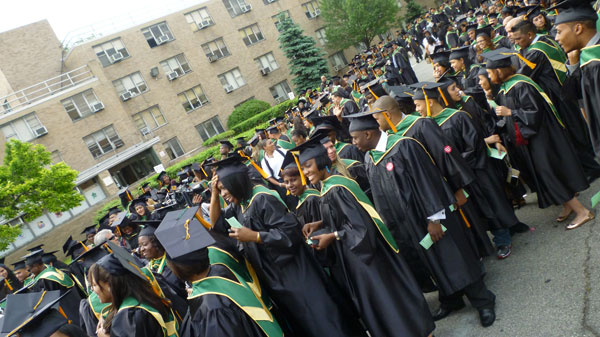
Photo by: Jarrett Murphy
Commencement 2010 at Bronx Community College.
Two years ago I attended commencement at Bronx Community College, and it was a lot more inspiring than any other graduation I’d been too, including my own. The graduating class was a sea of young people of color beaming as family members cheered them on. Many were the first in their family to go to college. Some had kids of their own already. A few who were singled out for awards had overcome tremendous obstacles, like arriving just a few years earlier with no English ability, and excelled. If for some reason you didn’t like CUNY, the scene would have been a good antidote.
But college is about more than the cap-and-gown visual, and it’s pretty disturbing when you meet a person who is about to get a college degree but clearly lacks basic skills, like the mother of two I know who is about to get her sheepskin from a local, lower-tier private college but cannot compose a sentence or understand basic documents. It’s unclear what good the degree will do her.
Sometimes colleges have a hard time pursuing the twin goals of inclusion and quality. In 2009, CUNY’s senior colleges raised standards for admission. A new report from the Community Service Society of New York (our owner) finds that this move had a cascading and profound effect upon the entire CUNY system:
“As a result, beginning in 2009, the makeup of CUNY colleges changed significantly. The incoming freshmen at top-tier schools had higher SAT scores and GPAs than those in previous years. Many students that previously had been able to enroll in top-tier schools were now enrolling in second-tier senior colleges. And more freshmen with scores that would have previously allowed them to get into a four-year college program were enrolling in community colleges.
“These dynamics had a clear impact, if an unintended one, on the racial and ethnic distribution of the CUNY system after 2008. Senior colleges, particularly the top-tier campuses, became much less likely to enroll black and Latino freshmen.“
Standards matter, but they may matter in a more complex way than people realize. According to the CSS report, colleges with higher graduation rates tend to better serve their students, regardless of how well-prepared those students are when they arrive. CUNY’s senior schools graduate at a higher rate than the community colleges, so the higher standards mean that students of color are being served by less-effective colleges.
“CUNY has the potential to be our city’s great equalizer—we should be careful not to let it reproduce and perpetuate patterns of inequality,” the report argues.
In other policy news:








